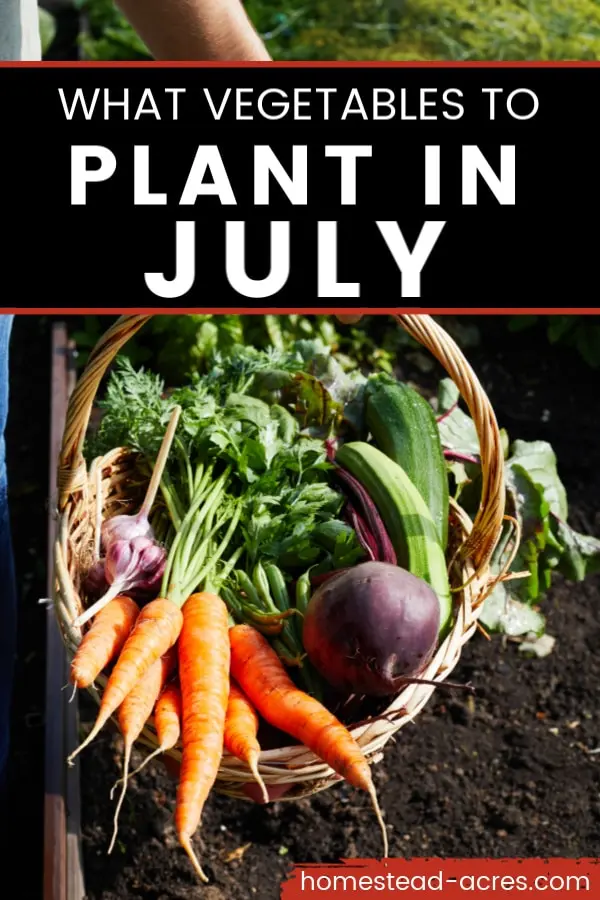This post may contain affiliate links, my full disclosure can be read here. As an Amazon Associate I earn from qualifying purchases.
Are you wondering what to plant in July?
If you missed out planting your garden in the spring don’t worry because there are still lots of vegetables you can plant in July and harvest from this summer and fall. From zone 3 to 10 there are vegetables you can grow in July successfully.
Actually, July is a great time to start a vegetable garden! Many of the pests commonly found in the spring-like flea beetles are starting to wind down.
The weather patterns have evened out so there is no risk of frost.
In cooler growing zones your focus is going to be on planting vegetables that will produce a quick harvest before your first fall frost.

Whereas in the warmer growing zones you are dealing with extreme heat so you’re going to focus on crops that love hot weather and providing extra shade and water.
What To Plant In Zone 3 In July

If you live in zone 3 you know that you have a short growing season. By July you need to focus on planting cool weather crops that will still produce well for you over the next few months as the weather keeps cooling down.
When planning your garden find out what your local first frost date is and calculate how many frost-free days you have left. Then pick varieties of vegetables that can mature within that time frame.
Leafy Greens
Peas
Peas are a great choice to start in July for a fall harvest in zone 3. Snow peas are the best type to go with because they can be harvested at any size and sooner than shell peas.
Peas planted in the summer will yield about half of what you normally get from spring-planted peas if you have short falls. So keep this in mind when planting and double the amount you plant for larger yields.
Turnips
Turnips are a great root vegetable you can plant by seed in your garden this month. For short growing, areas pick varieties that mature quickly. While purple top turnips are ready to harvest in 60 days many hybrids can be harvested in as little as 28 days.
Beets
Beets are a great vegetable for both the summer and fall garden. If you are planting in July pick a variety that grows in 60 days or less.
Beet leaves are also edible and can be used just like its cousin Swiss chard for an early harvest.
Carrots
Early July is the perfect time to sow carrots for your fall harvest in zone 3.
Carrot seed will germinate faster in the warm soil but mature in the cool fall temperatures giving you super sweet carrots to enjoy.
Just remember to keep the soil consistently moist until the carrots have germinated.
Brassicas

In zone 3 you can plant any vegetables in the brassica family in July. It’s best to start them by transplant if possible to give them the best head start. As the weather starts to cool down later in the season you’ll be rewarded with lots of sweet tasting vegetables.
- Kale
- Broccoli
- Cabbage
- Kohlrabi
- Cauliflower
What To Plant In Zone 4 In July

In zone 4 you still have enough warm days to start planting heat-loving plants. But before you start make sure you check your local first frost date and calculate how many frost-free days you have left.
This will help you chose the right varieties to plant so that you can still get a harvest before winter sets in.
Summer Squash
In July you can plant zucchini, pattypan, or crookneck squash and still get a good harvest in the late summer and fall.
Cucumbers
If you start cucumbers by seed in early July you can still get a nice harvest in the fall.
Look for varieties that produce early and make sure they are planted in full sun. You may need to provide some frost protection in the early fall.
Green Beans
You can still plant green beans in early July in zone 4 if you use bush varieties instead of pole beans. Bush beans produce much earlier between 50 and 70 days depending on the variety.
Sweet Corn
You might think that you can only plant sweet corn in the spring but you really can plant it in July and still get a harvest if you pick the right varieties.
Look for types of sweet corn that mature in 60 days and plant them in full sun. With the right care, you can start harvesting in early September.
Beets
You still have lots of time to plant beets in early to mid-July in zone 4. These root vegetables are cold hardy and taste even better after the cool weather starts in the fall.
Look for varieties that mature in about 60 days or less and start them by seed early in your garden.
Turnips
Turnips grow well in both hot and cool weather so are the perfect root vegetable for mid-summer planting.
Look for varieties that mature in 60 days or less to get a quick harvest.
Carrots
July is a great time to start planting carrots in zone 4. This vegetable has a reputation for being fussy to germinate but the naturally warmer soil of midsummer can really speed that up.
Just make sure to keep the soil nice and moist until the carrots have sprouted.
Pick short-season types of carrots that can mature in 60 days for an early fall harvest.
Radishes
Radishes are a quick growing vegetable that can be harvested in 28 days depending on the variety you grow.
Normally planted in the spring many radish varieties will struggle to grow and bolt in the hot summer weather. Try varieties like sora that have been grown to do well in the summer without bolting.
Greens
There is still lots of time to plant leafy greens in July if you live in zone 4.
While the summer heat can cause many greens to bolt the weather will start to cool soon. Try planting in an area of your garden that gets the morning sun and afternoon shade.
Brassicas
- Broccoli
- Cauliflower
- Cabbage
- Kohlrabi
What To Plant In Zones 5 and 6 In July

By early July in zones 5 and 6 you are starting to get lots of empty space in your garden as the spring crops have been harvested. But there are still many vegetables you can plant to keep your garden full and productive this month.
Cucumbers
A second planting of cucumbers in July has always done well for us in our zone 5 gardens. By this time of year, the cucumber beetle pests are starting to slow down.
Cucumbers planted at this time of year is starting to come into production in late August just as the first planting starts to burn out.
Summer Squash
Zucchini, pattypan, and other summer squash varieties are a great choice for planting in early July in zone 5 or 6.
Just like with cucumbers a common pest is cucumber beetles and their cycle is slowing down around the time you are starting your second planting.
Plant the squash in full sun and keep them well watered to get them off to a great start.
Zucchini planted in early July will start producing for you in early September and continue until the frost kills off the plants. You can extend this time with some good frost covers for your garden come fall.
Green Beans (bush beans)
Beans are another heat-loving vegetable that you can still plant in early July. For best results use bush beans instead of pole beans because they will be ready to harvest much sooner in just 50 to 60 days.
Sweet Corn
If you didn’t get your corn planted this spring there is still time if you pick a short season variety.
Look for types of sweet corn that mature in 60 days and plant them in full sun. With the right care, you can start harvesting in early September.
Green Onions
While it’s too late to be planting bulb onions there is still lots of time for growing green onions.
Green onions are ready to harvest in only 60 days but can be harvested sooner. You can also use the cut and come again method of just cutting off the greens and letting the plant regrow. This is faster than starting new onions by seed.
Kale
July is the perfect time to plant kale for your fall crop. Start it by seed or transplant in July and it will be ready to start harvesting baby greens from in just a few weeks.
But for the sweetest leaves wait until the fall after its been touched by a few light frosts. This makes the leaves taste super sweet!
Lettuce
Some people find lettuce hard to grow in the summer. As a cool-season crop lettuce tends to bolt when the hot temperatures arrive. But if you focus on varieties of lettuce that have been developed to grow well in the summer heat and make sure they are well watered you can still grow sweet lettuce in the summer.
See our lettuce growing guide to learn how to grow lettuce successfully.
Peas
Starting a planting of peas in early July will give you a nice sized harvest in September and October.
I find snow peas are the best ones to plant because they are ready to harvest at any size so if you have an early fall you still get a good return on your planting. But shell peas can also work if you live in an area that long falls.
Fall pea plantings will normally give you half the harvest as your spring plantings so keep this in mind when you are planning your garden.
Beets
July is the perfect time to plant beets in your zone 5 and 6 garden for a fall harvest. If you plant them in early July they will be ready to start harvesting by the end of August or sooner depending on the variety you’re growing.
Turnips
July is a great time to plant turnips in zones 5 and 6. By now the flea beetle cycle is starting to slow down making it easier to grow turnips.
Depending on the variety you plant you can start harvesting in 30 to 60 days. Since turnips are also very cold hardy, why not sow a new planting every 1-2 weeks in July for a long harvest this fall.
Carrots
By July the soil temperature is nice and warm making it easier to germinate carrot seed quickly. Just remember to keep the soil good and moist as it can dry out quickly in the summer heat.
Choose varieties of carrots that mature in 60 days so you can have a late summer and early fall harvest.
Radishes
While you might think of radishes as a spring vegetable if you grow the right types you can still plant and harvest in the summer. Look for varieties like sora that have been developed to not bolt in hot weather.
Keep radishes watered consistently and provide shade if possible for the best results in July.
What To Plant In Zone 7 and 8 In July

If you live in zones 7 or 8 your garden planting in July will be focused on heat-loving crops.
You’ll first want to look up your local first frost date it will help you a lot in planning what you are going to plant. Just like other garden zones in the USA zone 7 and 8 cover large sections from the east coast, south, and up the west coast.
There will be some crops that will grow great in July in one area but might not do well in yours.
As long as you have 75 to 80 days before your first frost these vegetables should do well for you.
Sweet Corn
Corn loves heat so a crop planted in early July will get off to a quick start if you keep it well watered. For an early harvest go with a 60-day variety and you’ll have sweet corn starting in early September.
Green beans (bush beans)
In zones 7 and 8 you can still plant and grow green beans in July. Bush beans are the best type to grow this time of year because they mature in 60 to 70 days whereas pole beans can take longer to start producing.
Cucumbers
Cucumbers planted in the mid-summer will give you a smaller harvest then if they are started in the spring. But it’s still well worth planting!
They will start producing in just a few months giving you fresh cucumbers late in the summer and through until the frost kills off the plants.
Summer Squash
Summer squash varieties like zucchini, pattypan, and crookneck are perfect for planting in July.
Your harvest will be smaller than spring plantings but you may have fewer problems with garden pests.
Leafy Greens
- Kale
- Swiss chard
- Collards
- New Zealand spinach
Seeds to start indoors for your fall garden in zone 7

- Cauliflower
- Brussels sprouts
- Cabbage
- Broccoli
- Kale
- Kohlrabi
What You Can Plant In Zones 9 and 10 In July

Zones 9 and 10 cover wildly different growing areas so it’s important to remember this when you are looking at the following list of plants you can grow.
If you live in a blazing hot desert area what you’ll be able to plant this month could be very different from coastal areas of Florida and California.
This month will be all about heat living crops but even they can benefit from adding shade to your garden with shade cloths or planting under trees that can help protect plants from extreme heat.
Summer squash
Summer squash is a hot weather loving plant you can start in your gardens in zones 9 and 10. Try growing zucchini, pattypans, or crookneck squash.
Beans
Green beans thrive in warm weather and with your long growing season, you can plant either bush beans or pole beans.
Sweet Corn
Sweet corn is another heat-loving vegetable. Just make sure to provide it with lots of water as corn has a shallow root system.
We love planting corn in the square foot method to get a lot out of a small space.
Cucumbers
Cucumbers are perfect to plant in July. They love the warm weather and as long as they get lots of water will do well and start producing for you as soon as 60 days after planting depending on the variety.
Southern Peas
Southern peas are a heat-loving plant that thrives in hot summer weather. They take 60 to 90 days to reach harvest depending on the variety and growing conditions.
Okra
Thrives in the hot summer weather of zone 9 when many other plants can fail. The key to keeping it growing well is watering. The extreme summer heat quickly evaporates water from the soil so make sure you keep up on watering and mulch well.
Seeds To Start Indoors In July In Zone 9 and 10
July is the perfect time to start seedlings indoors so they are ready to transplant into your garden as the heat of summer eases up.
You’ll want to start these plants indoors:
Connect With Homestead Acres!
Be sure to follow me on social media, so you never miss a post!
Facebook | Twitter | Pinterest | Twitter
Visit my Amazon store to find all my favorite gardening, homesteading tools, and gadgets plus all of my printed garden books and journals!

Kim Mills is a homeschooling mom of 6 and lives on an urban homestead in Ontario, Canada. Blogging at Homestead Acres she enjoys sharing tips to help you save money, grow and preserve your own food.

Annette
Tuesday 14th of July 2020
I was planning on doing some planting, I'll have to try my peas again. :) Lettuces I always do again, and I'm planting more kale too.